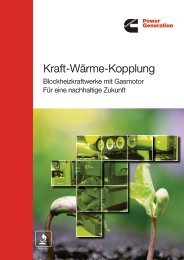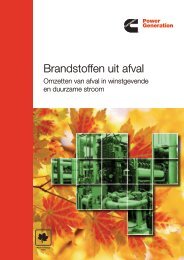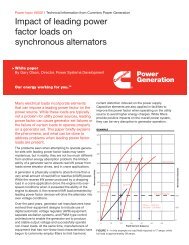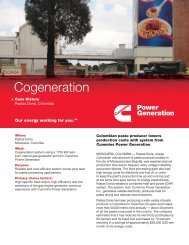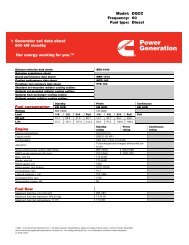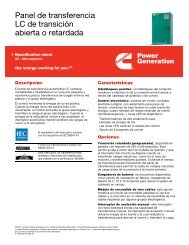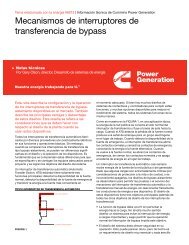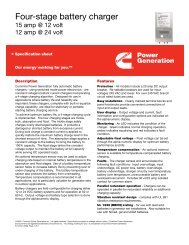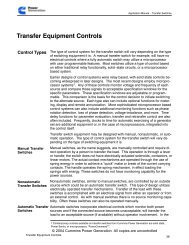appendix
appendix
appendix
You also want an ePaper? Increase the reach of your titles
YUMPU automatically turns print PDFs into web optimized ePapers that Google loves.
Application Manual – Liquid Cooled Generator Sets<br />
APPENDIX B<br />
Reduced<br />
Voltage Motor<br />
Starting<br />
A Comparison of<br />
Motor Starting<br />
Methods<br />
Full Voltage Motor<br />
Starting<br />
Although voltage dip often causes various problems, a controlled reduction in voltage at<br />
the motor terminals can be beneficial when it is used to reduce the starting kVA of a<br />
motor in applications where the reduced motor torque is acceptable. Reducing motor<br />
starting kVA can reduce the size of the required generator set, lessen the voltage dip, and<br />
provide a softer start for the motor loads. Make sure, however, that the motor will<br />
develop sufficient torque to accelerate the load under reduced voltage conditions. Also,<br />
any starter that makes a transition between “start” and “run” can cause an inrush<br />
condition nearly as severe as across–the–line starting –– unless the motor is at or near<br />
synchronous speed at transition. This may cause unacceptable voltage dip and<br />
potentially starter drop–out.<br />
Table B–1 compares the effects of full voltage, auto–transformer, and resistor starting on<br />
a 50 horsepower, Design B, Code G motor. As can be seen, autotransformer starting<br />
requires less motor starting capacity from the generator set. Resistor starting actually<br />
requires more kW (engine power) than across–the–line starting.<br />
% of applied voltage<br />
(tap)<br />
% of full voltage<br />
(multiplier) *<br />
Starting kVA with<br />
reduced voltage<br />
starter<br />
Starting kW with<br />
reduced voltage<br />
starter (kVA x PF)<br />
AUTOTRANS-<br />
FORMER<br />
TYPE OF STARTER<br />
RESISTOR FULL VOLTAGE<br />
65 50 100<br />
0.42 0.50 1.0<br />
295 ** x 0.42 = 123.9 295 ** x 0.50 = 147.5 295 ** x 1.0 = 295<br />
123.9 x 0.36***=<br />
43.4<br />
147.5 x 0.8****= 118 295x 0.36***= 106.9<br />
Run kVA 46 46 46<br />
Run kW 41 41 41<br />
* See Table 3–4<br />
** See Table 3–5 and multiply horsepower of 50 by the factor of 5.9 for Code Letter G.<br />
*** See Table 3–6<br />
**** See SPF for Resistor in Table 3–4<br />
Table B–1. Reduced Voltage Motor Starting Comparison<br />
Starting: Full voltage, across–the–line starting is typical unless it is necessary to reduce<br />
motor starting kVA because of the limited capacity of the generator set or to limit voltage<br />
dip during motor starting. There is no limit to the HP, size, voltage, or type of motor.<br />
Application Notes: This method is most common because of its simplicity, reliability, and<br />
initial cost. Note on the kVA and torque curves that starting kVA remains fairly constant<br />
until the motor almost reaches full speed. Also note that kW peaks at about 300 percent<br />
of rated kW near 80 percent of synchronous speed.<br />
B–2 APPENDIX B<br />
Rev. Jan 2011



